REVIEW – ADA Large Assault Pack
- ITEM: Pack, Large Assault
MANUFACTURER: ADA (Australian Defence Apparel)
DESCRIPTION:
An external frame, dismounted combat pack. This was the pack that was selected as the winner of the latest SCE Tender (Land125-3B) held by the ADF.
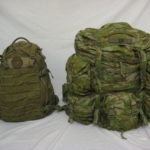
.
.
REVIEW NOTES:
This pack has been kindly supplied for review by a long-time supporter and follower of Packs and Beyond. Because of his efforts to support this site by playing editing elf, I am being coerced into suggesting he’s a decent bloke.
.
The pack in question has recently been issued under the new SCE (Soldier Combat Ensemble) programme with the ADF (Australian Defence Force).
It should be noted that Packs and Beyond had some significant role consulting for other tender entries that competed against this pack. So it is considered beneficial to our readers to contrast and compare the commercial entries that were available on offer to the ADF SCE Tender, with the winning suite of equipment.
Should one wish to compare the commercial offerings that were tendered for this contract, one should look no further at many of the other reviews of packs found on this very website.
Don’t forget to follow Packs and Beyond on Facebook (https://www.facebook.com/packsandbeyond) for all our latest updates.
.
.
LINK:
https://www.ada.com.au/
.
.
SPECIFICATIONS:
Materials –
Low density injection moulded plastic
1000D cordura AMCP (Australian MultiCam Pattern)
Fastex clips
YKK zips
Printed AMCP webbing tape
.
Dimensions –
Height: 58cm (approx. 22.8in) to storm collar
Depth: 32 cm (approx. 12.6in)
Width: 38cm (approx. 15in)
Weight: 4.20kg (approx. 9.25lb)
Volume: 90 L (approx. 5492 cubic inches)
.
.
LAYOUT:
ATS RAID on the left, and the ADA Large Assault Pack on the left.
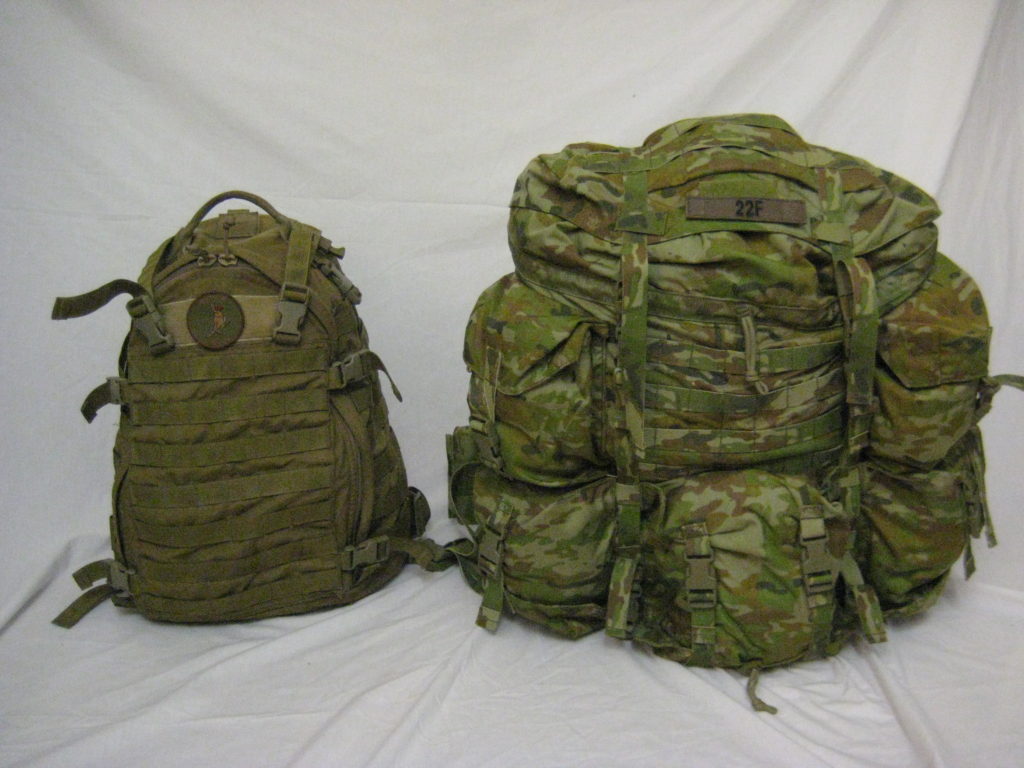
.
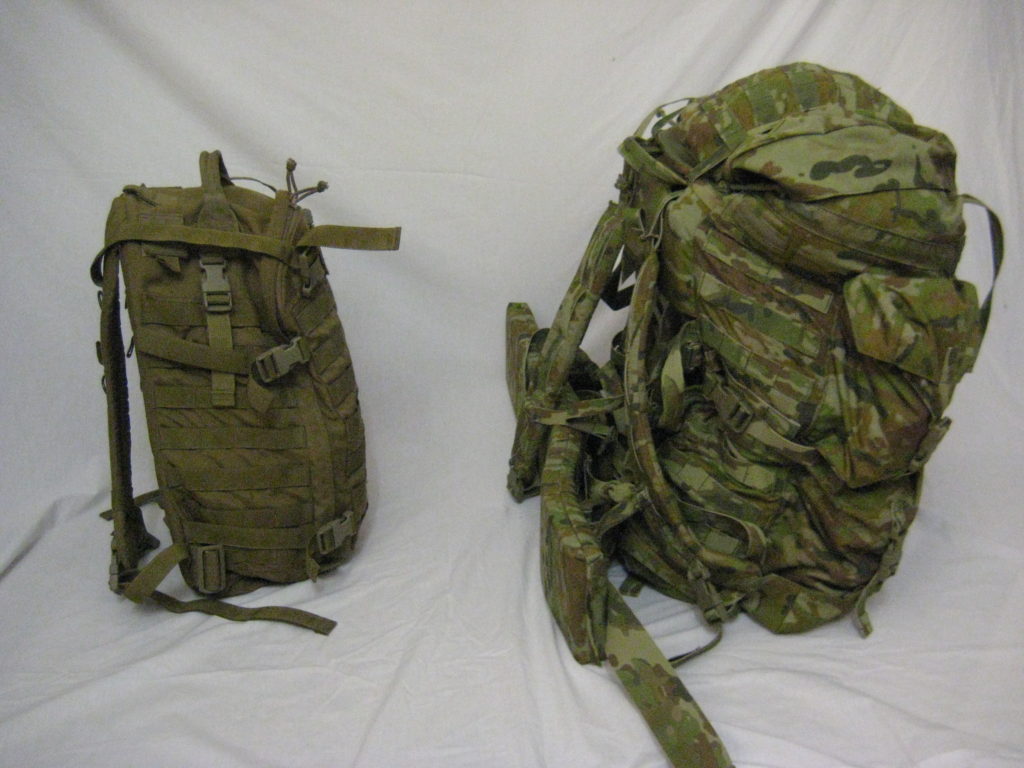
.
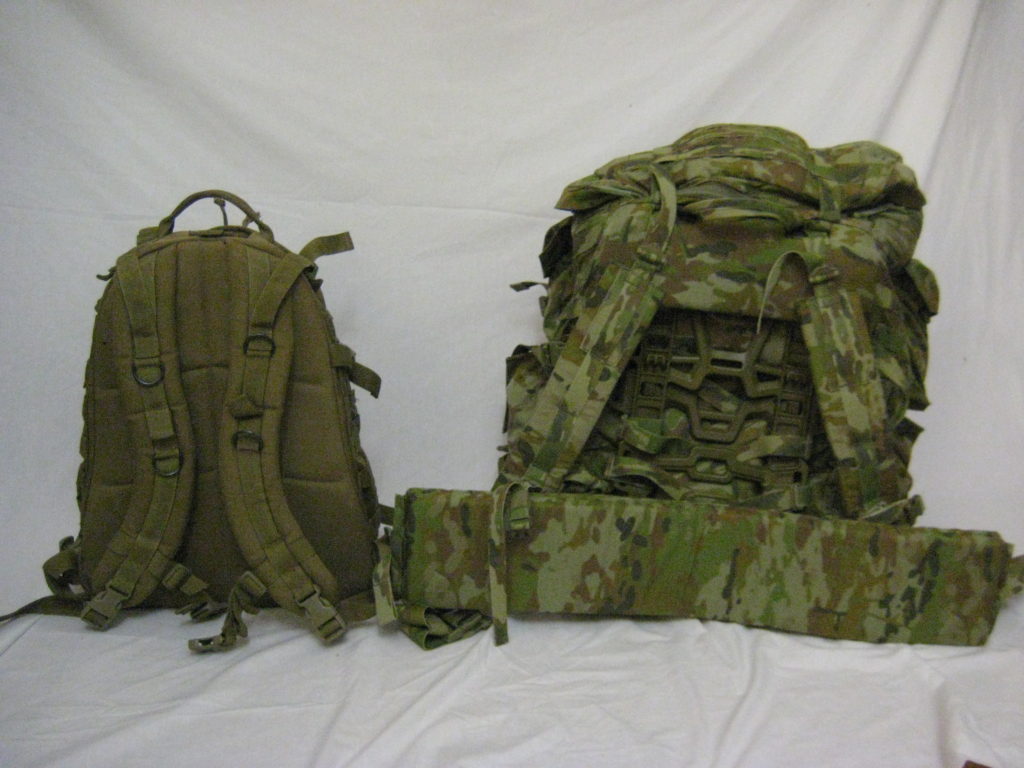
.
FRAME AND HARNESS –
The external frame (known as the One299 adjustable frame) is quite a unique concept. Unlike other frames, this one is composed of two separate pieces.
This plastic frame is in two pieces in order to be correctly sized to the back-length of individual wearer.
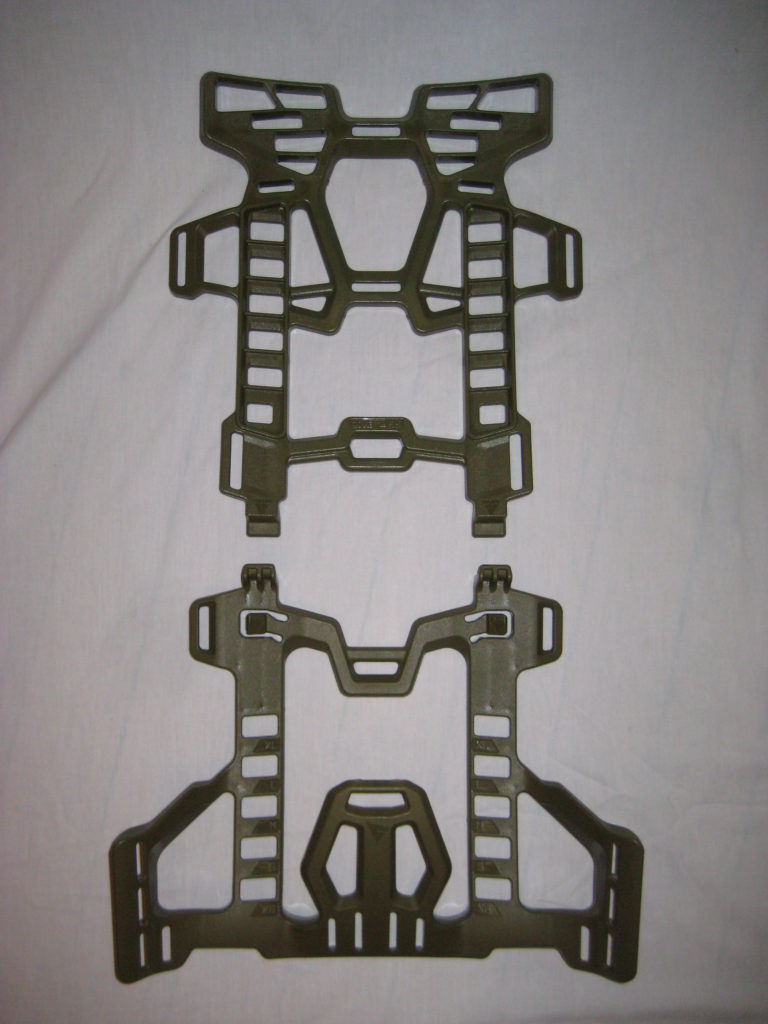
.
It has locking lugs that allow the frame’s back-length to be modified.
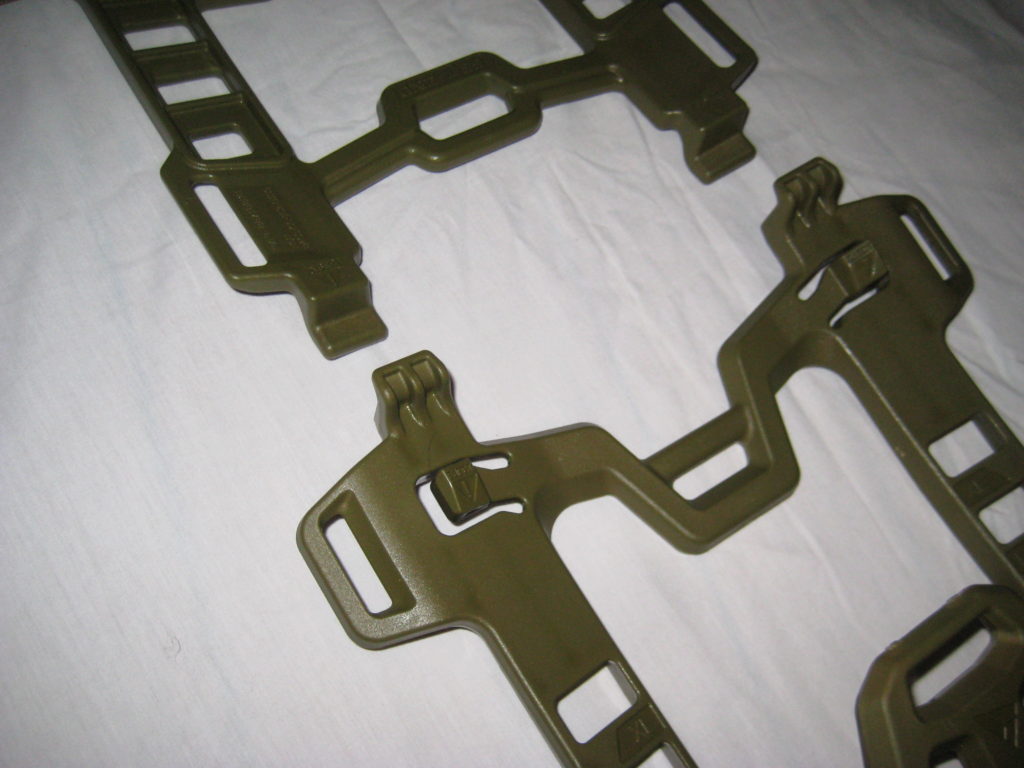
.
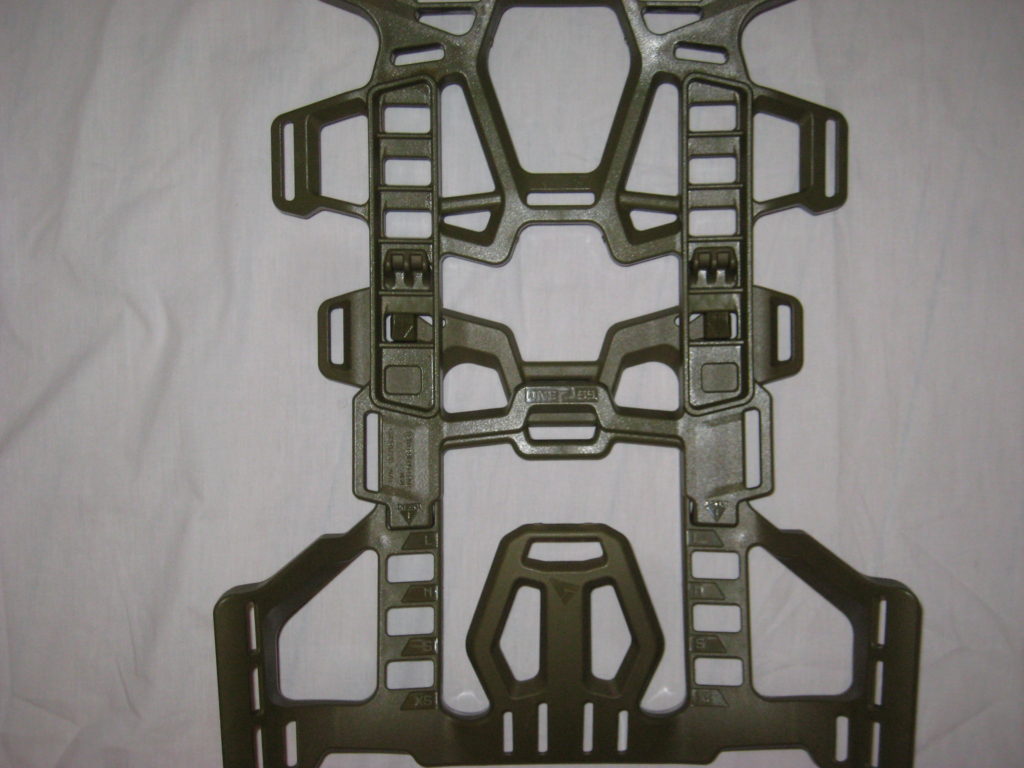 .
. 
.
There appear to be various locations for the rucksack to be anchored to the frame. But in reality, when trying to fit the frame to the rucksack, there doesn’t appear to be any way to properly achieve this.
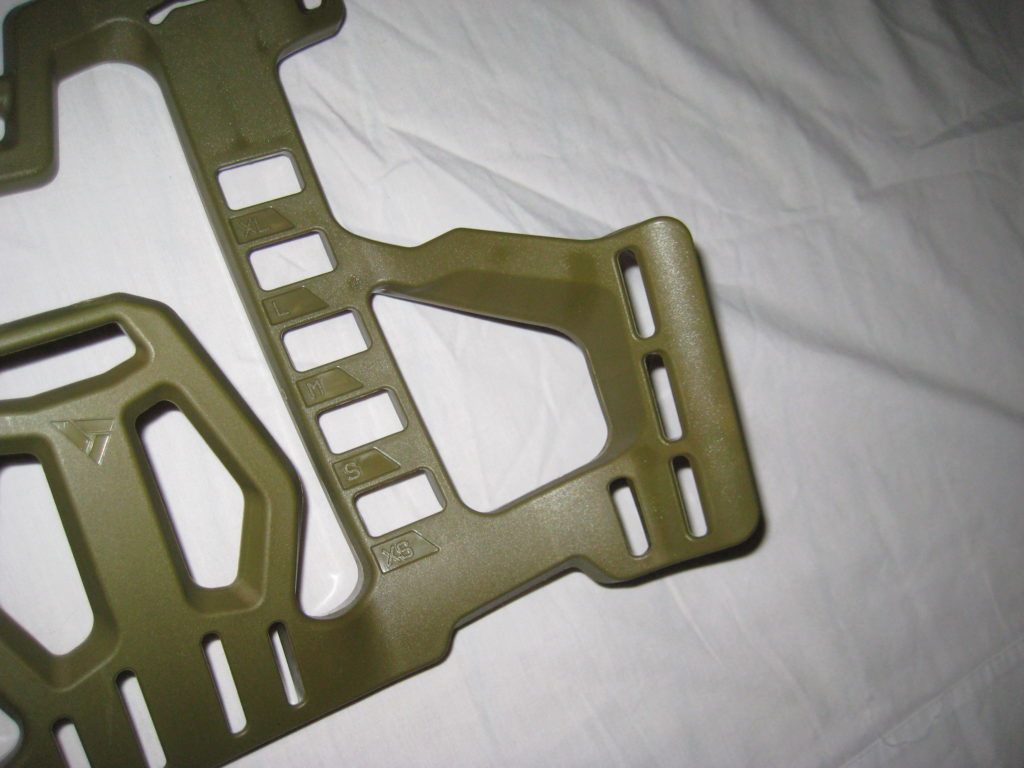
.
The bottom of the frame has a large protuberance at the bottom, squarely in the small of the user’s back.
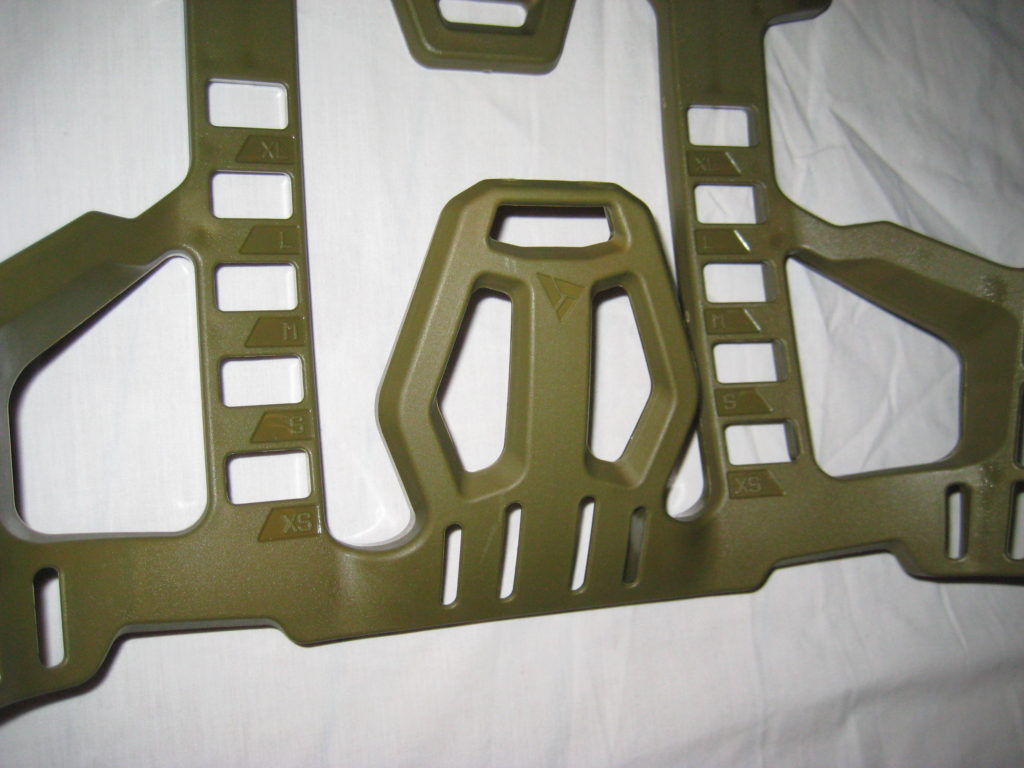
.

.
While the frame gives an initial appearance of being high-tech, the harness is a distinct step back in time.
The shoulder straps are padded and slightly contoured. They lack any 3D structure which means they will fold up to string under load, even more so if wet..
The straps are secured at the top end to the frame via old steel ALICE buckles.

.
Strangely, for a newer design, these shoulder straps lack load lifter straps such as that found on any other modern design available in the market.
There is an adjustable sternum strap fitted. This can be removed and adjusted for height to suit the wearer.
At the bottom of each strap is a Fastex clip to give quick release capability. Unfortunately, these buckles are not rated for the loads that are typically carried by end-users in the ADF.
In addition, these quick release buckles are only anchored at the top, and have a great amount of free movement that is not covered by the padding from the strap.
The hip belt is a very large rectangle of foam. It is attached to the frame via four large steel ALICE buckles. There is a large plastic plate to offer some 3D structure and rigidity at the anchor point of this hip belt.
This hip belt has no ergonomic contouring for the human body. I’m not even sure it’s meant to be used in the real world. As it stands, this hip belt does not interact well with belt mounted webbing (fighting load) or with body armour.
.
RUCKSACK –
The lid is non-detachable, with a field of PALS rows on top to allow user-customisable pouches to be attached.
At the top of the lid are two Velcro-covered ports to allow radio antennae to be routed out. These however, are of limited utility since the straps used to secure the rucksack lid run straight over the top of them.

.
At the very top of the rucksack, at the junction of the lid is a double-headed zip to allow routing of radio handsets and hydration bladder hoses.
There is also a field of loop Velcro at the bottom of the lid to attach IFF patches.
.
Under the lid there are two pockets. One is secured via a very fine strip of velcro, which I suspect will have a very short service life under field conditions. The other is secured via zip, ostensibly for maps or other admin items.
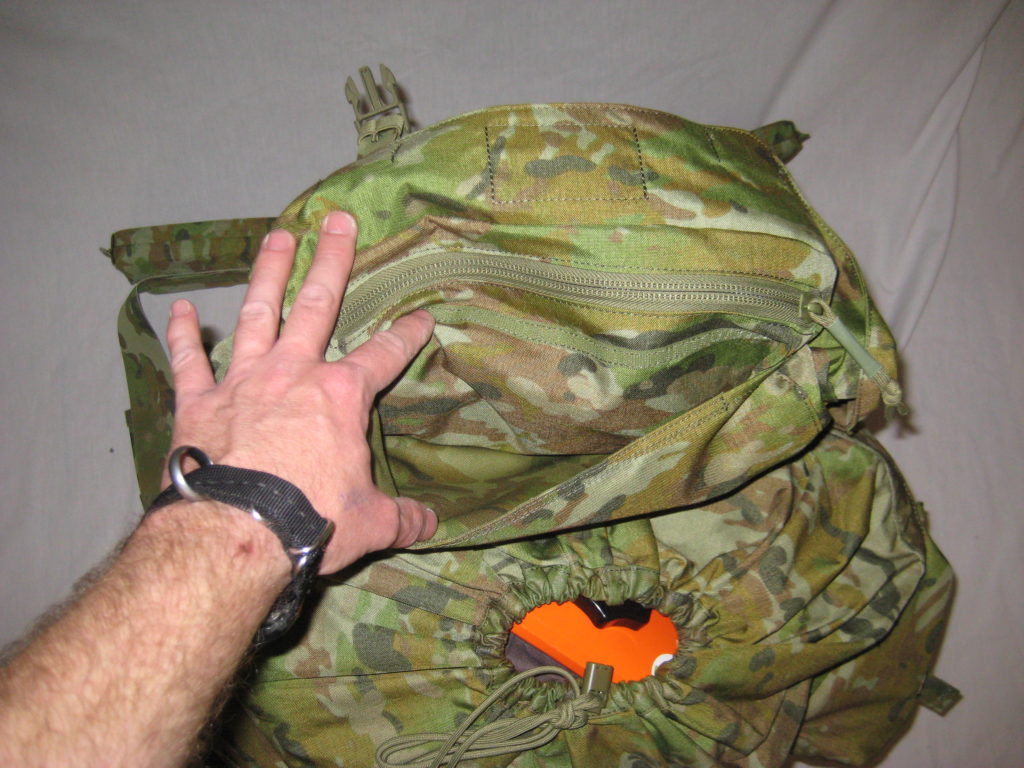
.
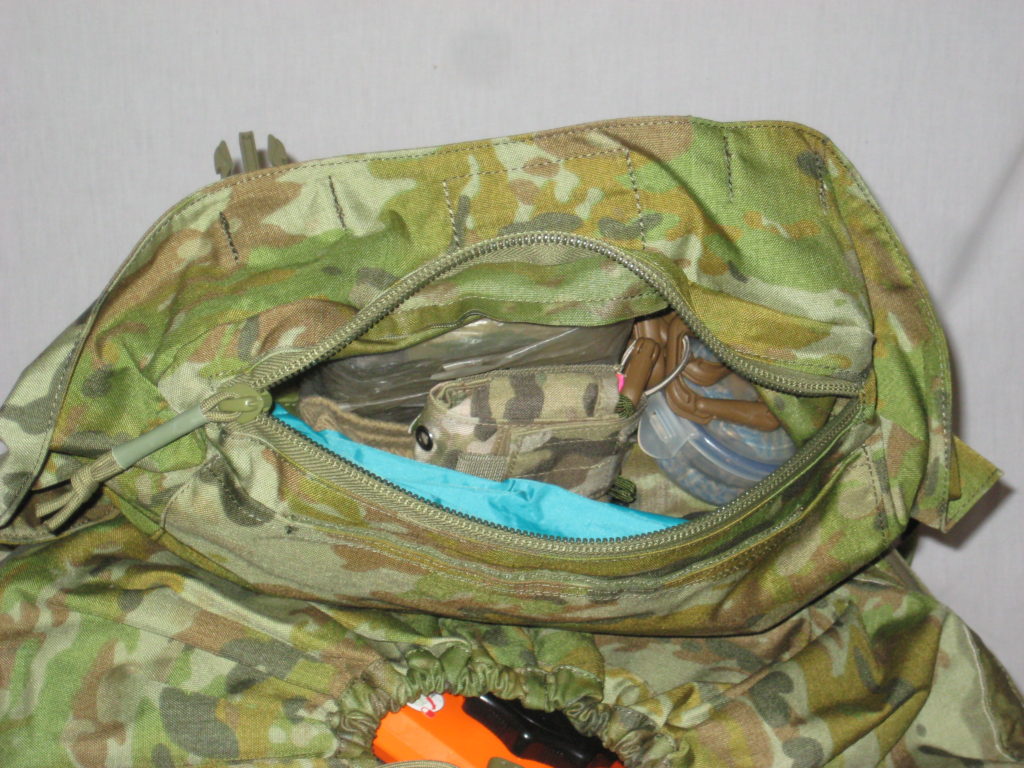
.
The main compartment is secured with a dual draw-string storm collar to seal the pack up against the elements and allow extra capacity to be packed in.
This storm collar allows a much greater capacity to expand the pack capacity should extra equipment be carried. There are two hose/cable ports on the storm collar to allow routing out of the pack. There are another two of these ports on the side of the pack. These ports are made of what appears to be elasticated foam with edging tape sewn onto them. They are quite rough, with missed and blown stitching on an item that hasn’t seen any field use.
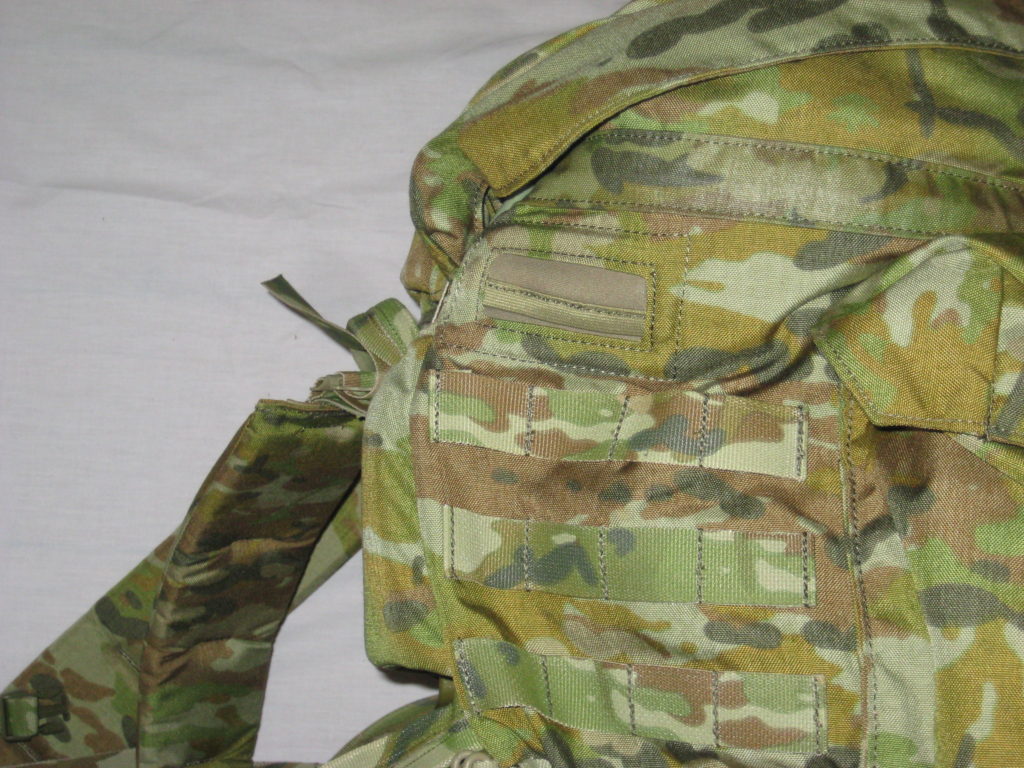
.
On each external side of the rucksack, is a field of PALS rows to allow the user to add their own pouches to customise their load.
Strangely, there appears to be only one compression strap on this pack, which is positioned in the middle of the rucksack. It doesn’t appear to actually do much in the way of compression of the load if required.
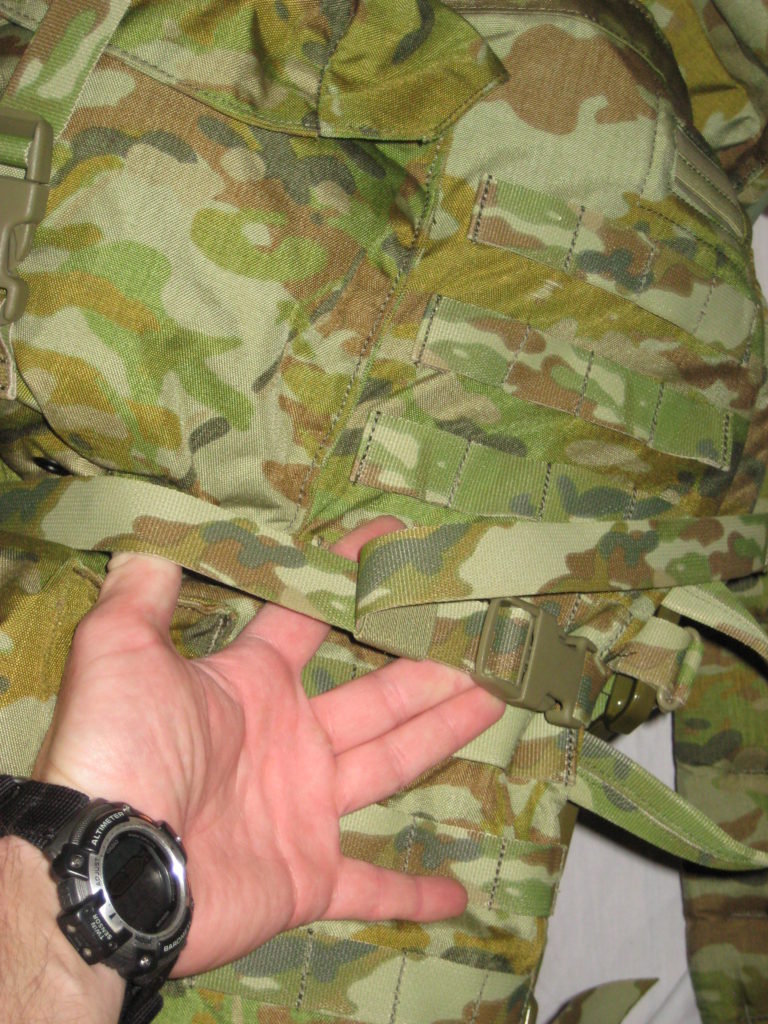
.
On the dorsal corner of the rucksack are two pouches. These are in a similar location and placement as the long dorsal pouches as seen on Mystery Ranch packs. These dorsal pouches are of unusual layout. The top row of pouches are fairly standard, they are are Minimi (SAW) pouch sized (170mm wide x 90mm deep x 200mm long or 6.7in x 3.5in x 7.9in) with the lid on the top, secured via draw-cord and fastex clip. There is a drain-hole on the bottom. The next pouch down is a mirror image – that is, inverted with the pouch lid on the bottom to allow access. And thankfully, the drain-hole is located in the lid – the pouches lowest point. Whilst unusual and could be considered innovative, there are issues with this design, which I will discuss in greater detail later.
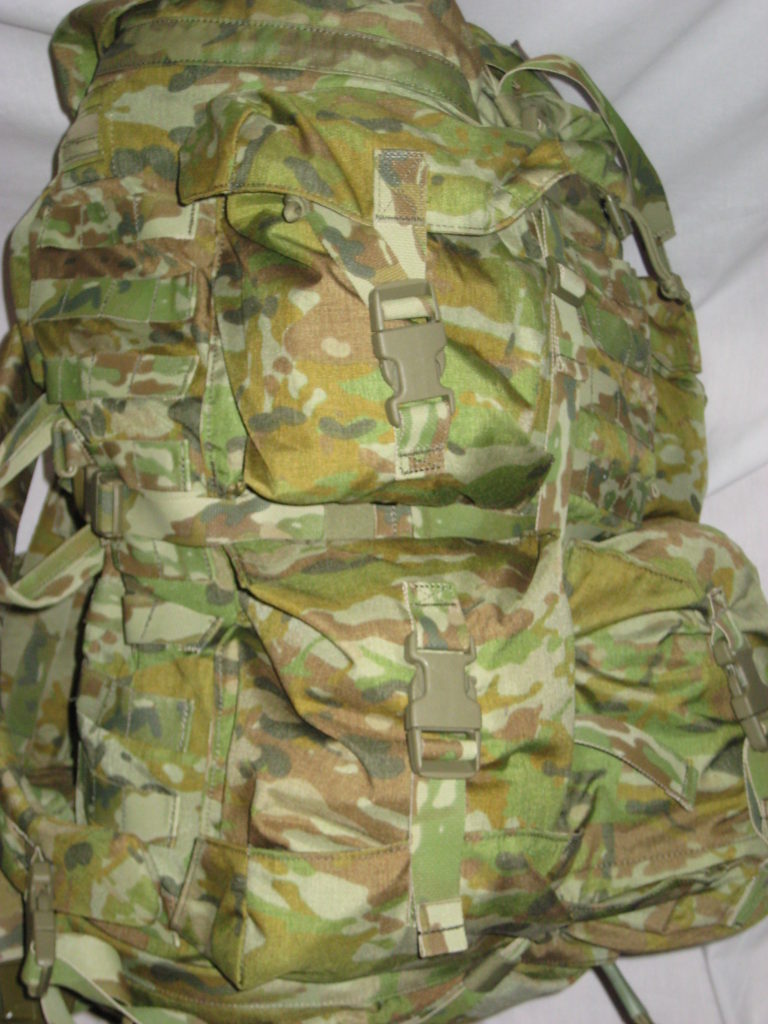
.
The central panel of the rucksack has another field of PALS rows, ostensibly to stow an entrenching tool. Below this is another inverted pouch secured with double fastex clips and draw-string.
.
At the bottom of the pack is a large clam-shell zip for sleeping bag access. This also has another velcro secured pocket for small admin items.
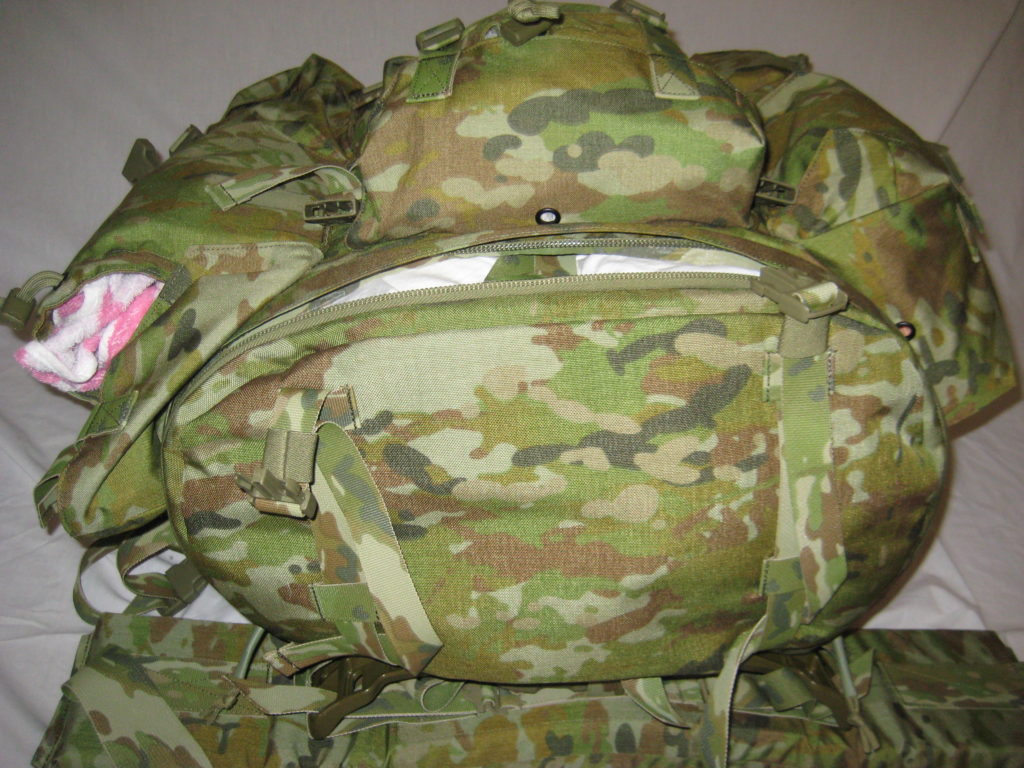 .
.
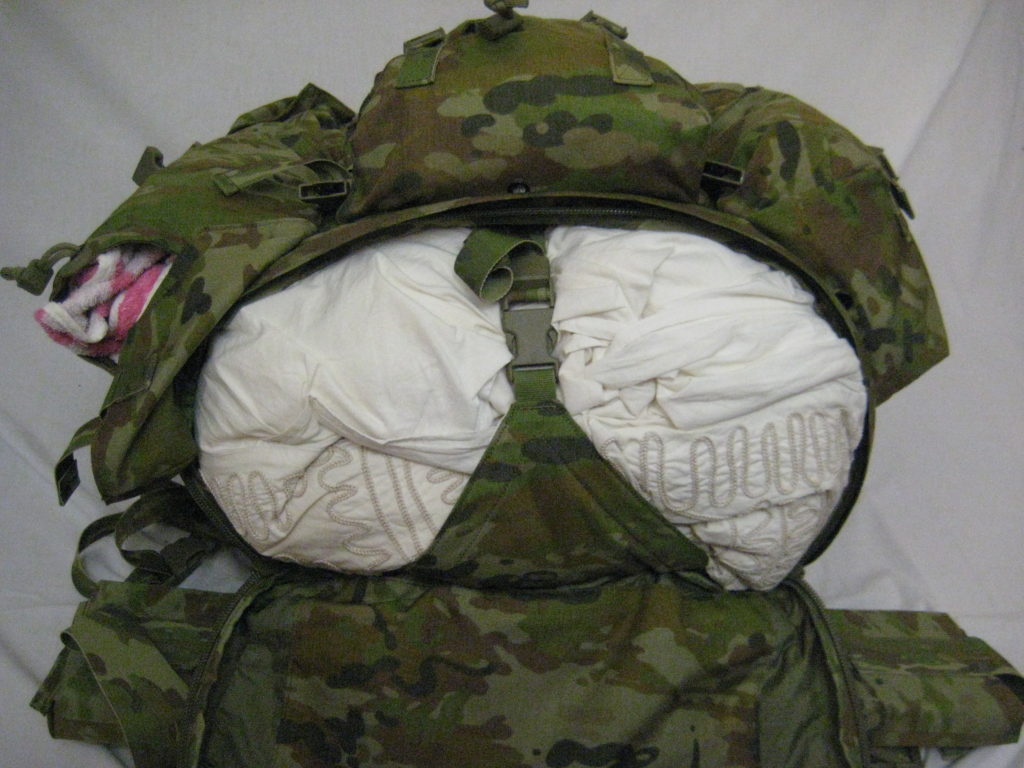
.
There are straps to secure both top and bottom portions of the pack. Unlike other designs, these straps aren’t anchored to the main body of the rucksack. They are secured via webbing loops on the rucksack body allowing abrasion to wear them down.

.
There is some internal organisation of the rucksack.
The main compartment is divided into two halves, separated by a zipped shelf.
Top view:
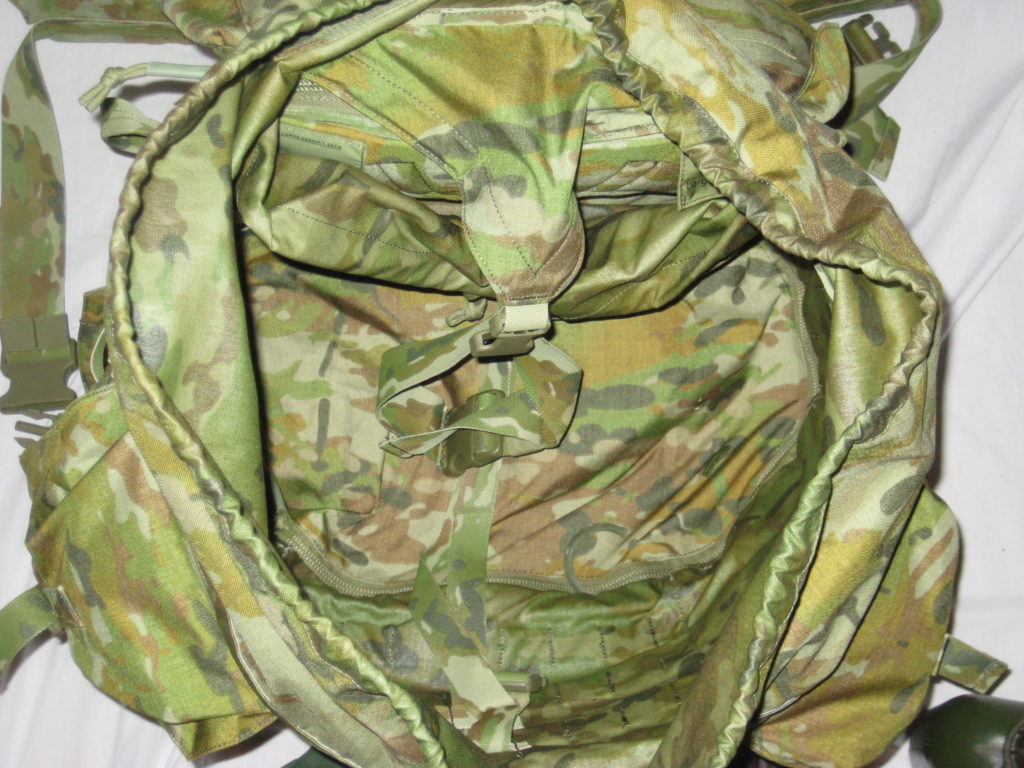
.
Bottom view:
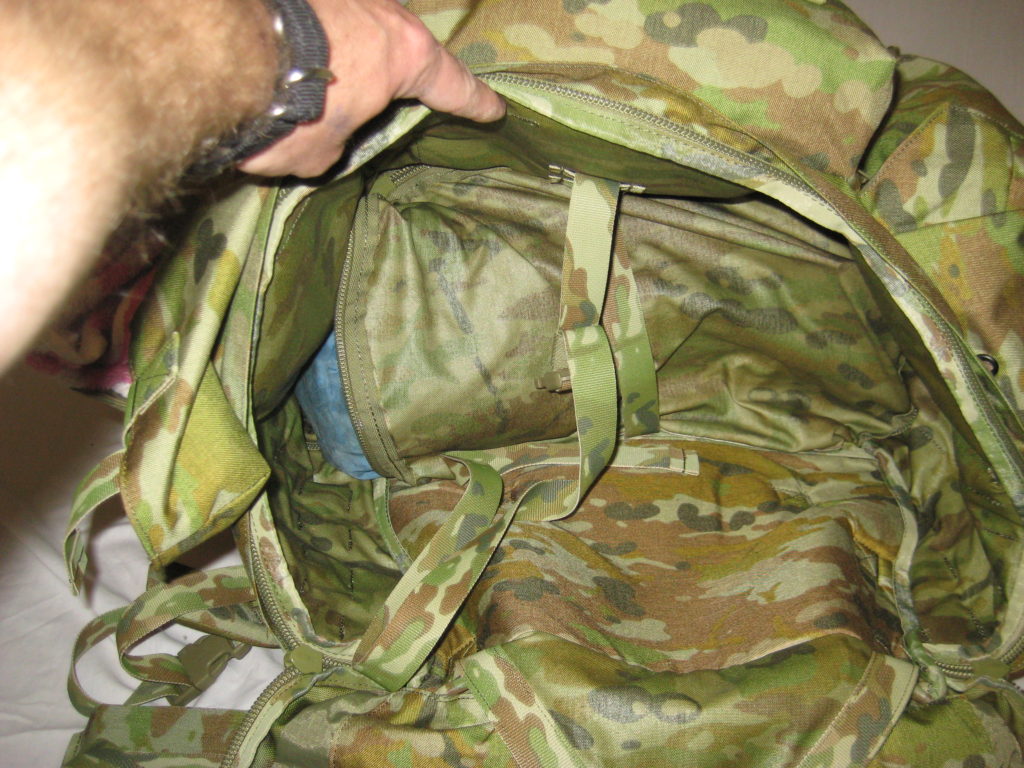
.
The top half has a pocket and webbing harness to carry a manpack radio.

.
The bottom half has a webbing harness to secure a sleeping bag and other sleeping equipment.
.
All zip pulls have paracord pull tabs with electrical shrink wrap to aid gripping.
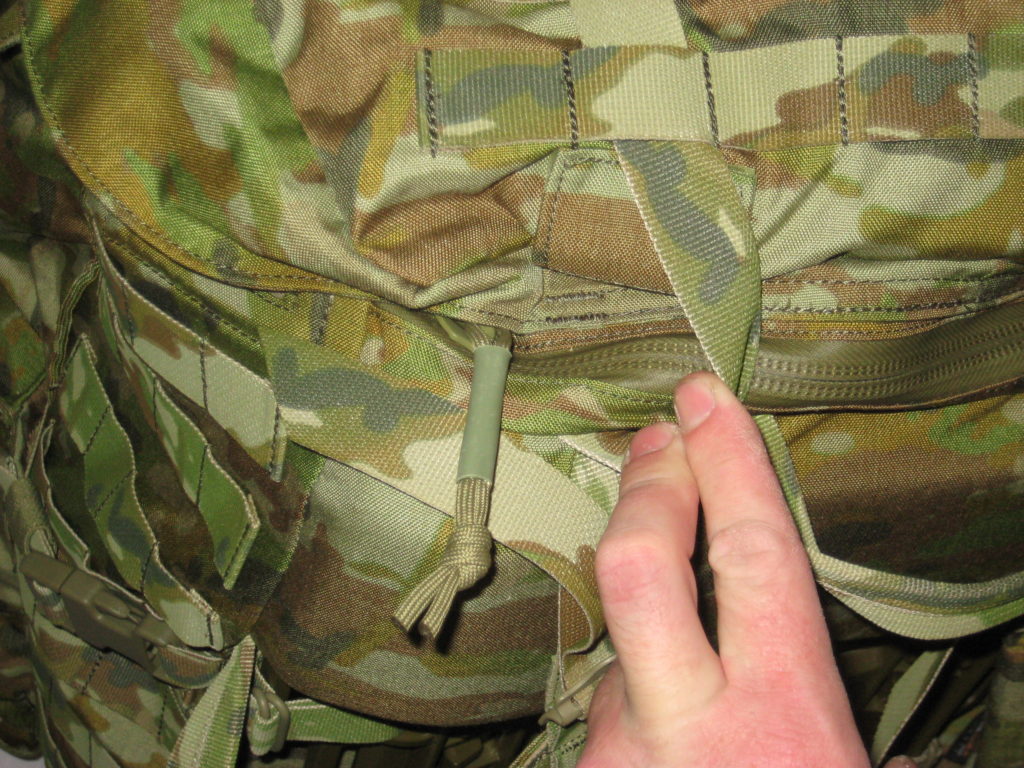
.
On the top and sides of the rucksack are substantial carry handles.
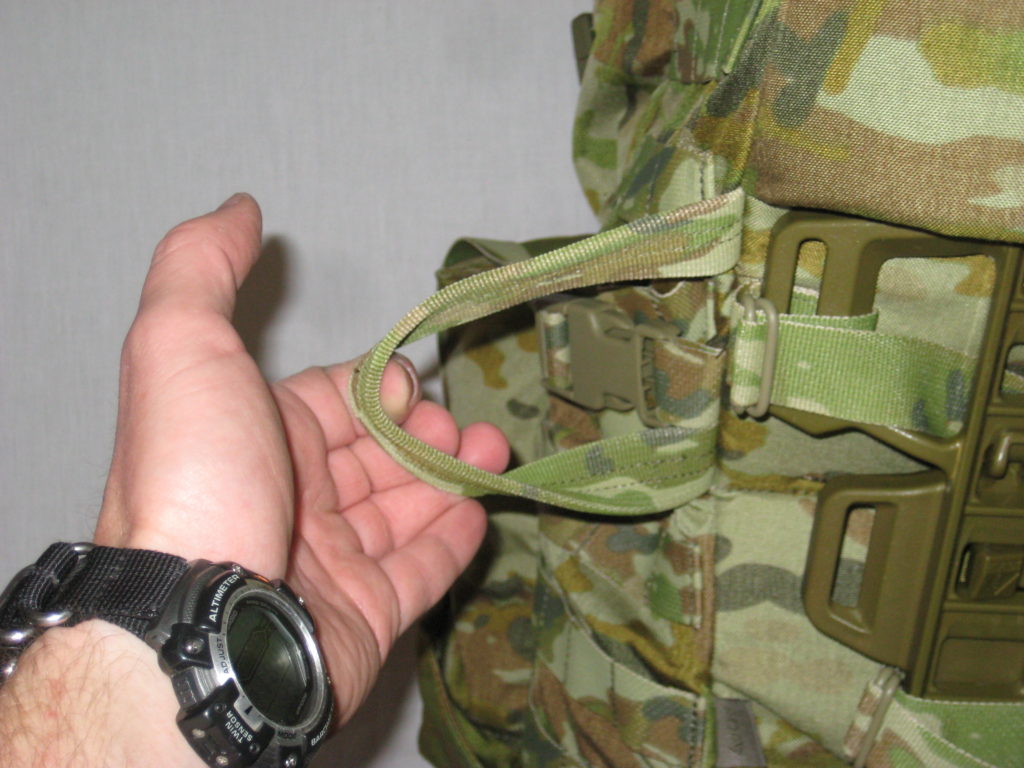
.
.
PERSONAL ASSESSMENT:
Being worn, Large Assault Pack only.
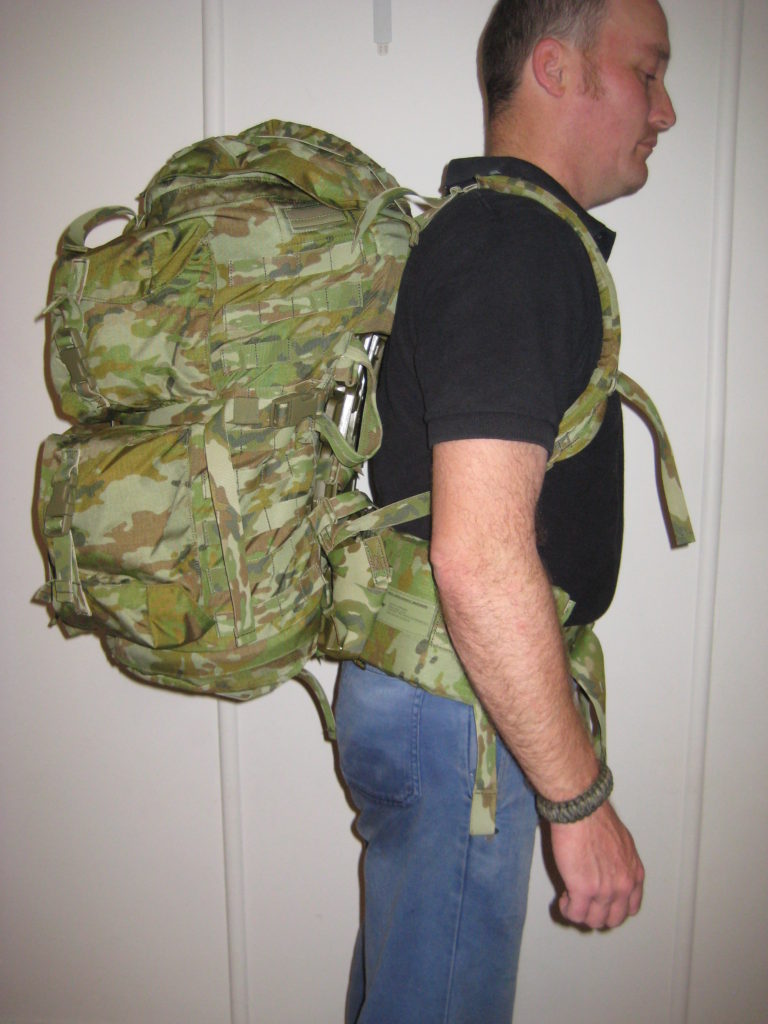
.
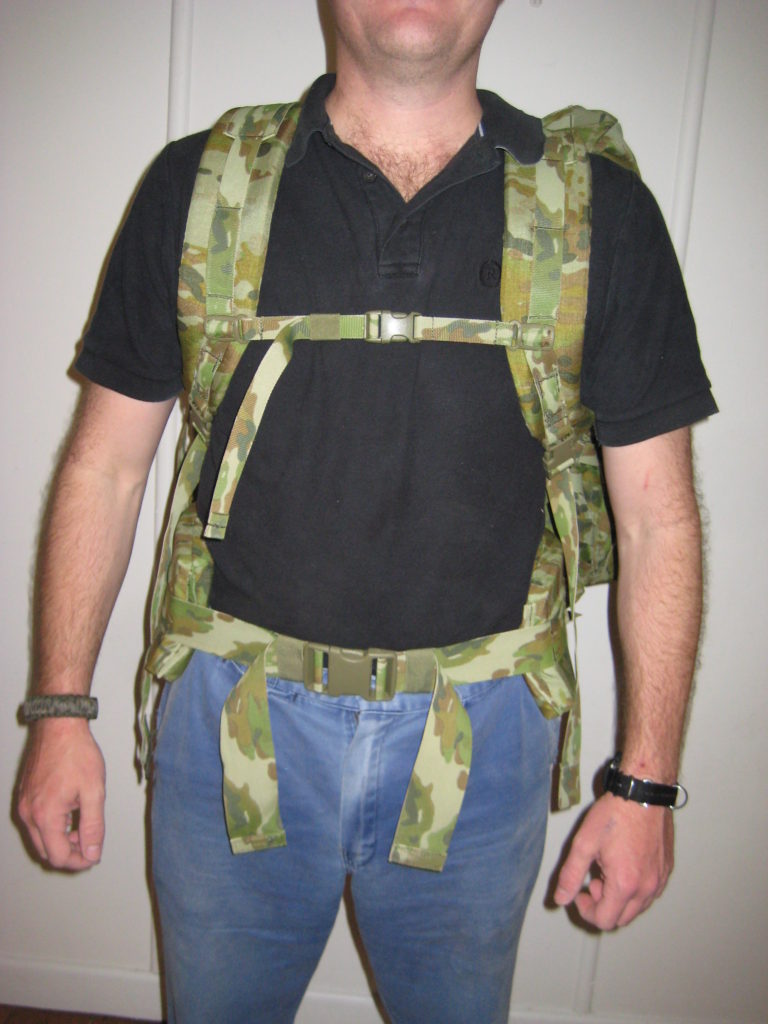
.
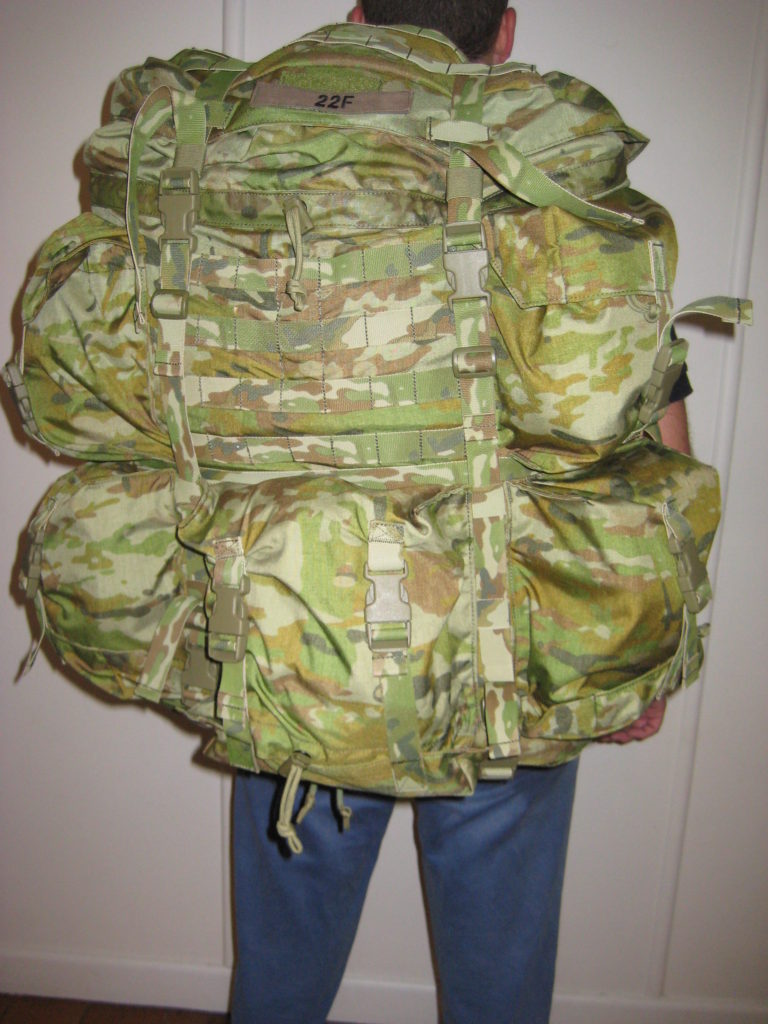
.
Being worn, in conjunction with belt webbing.
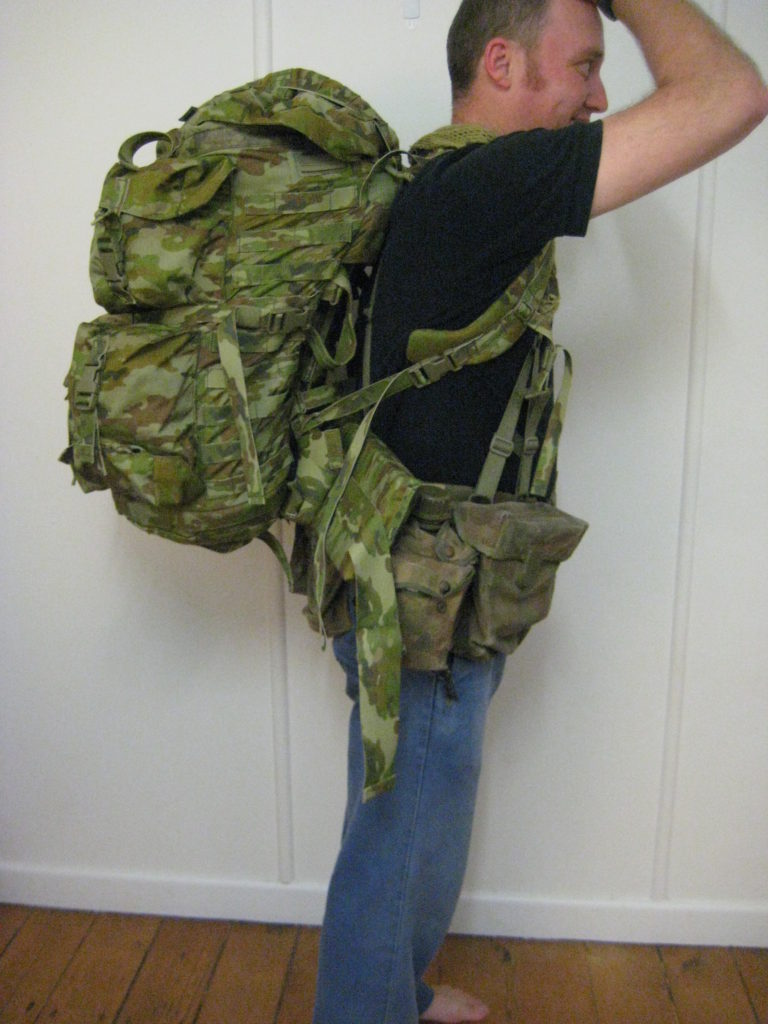
.
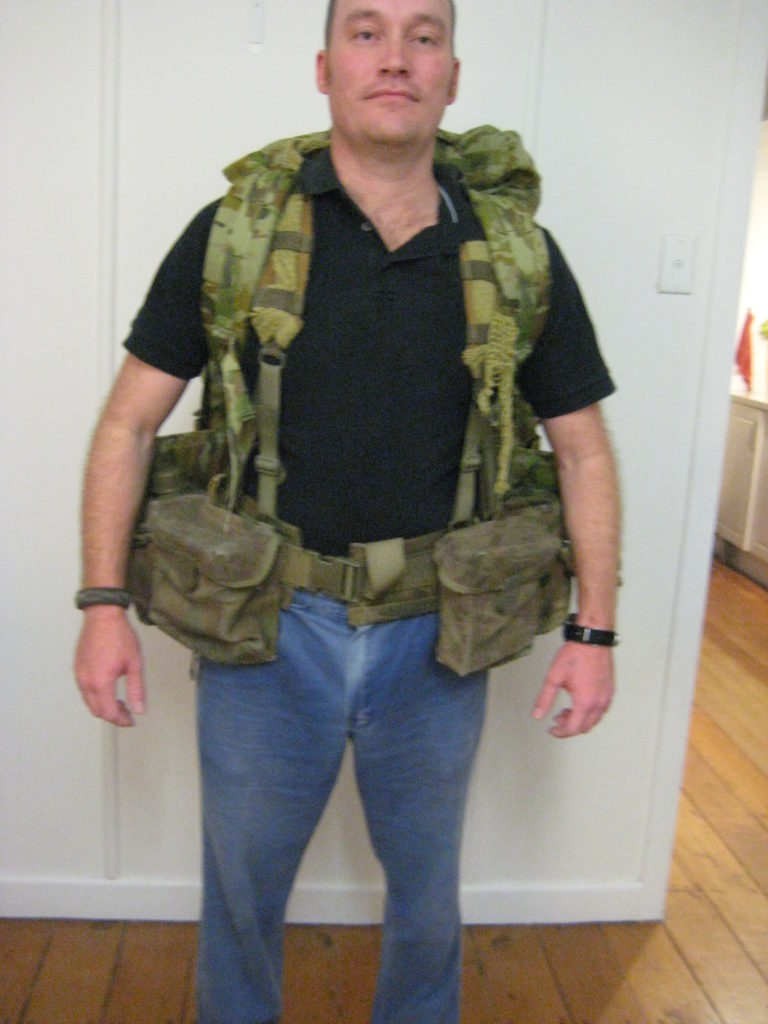
.
Being worn in conjunction with a plate carrier.
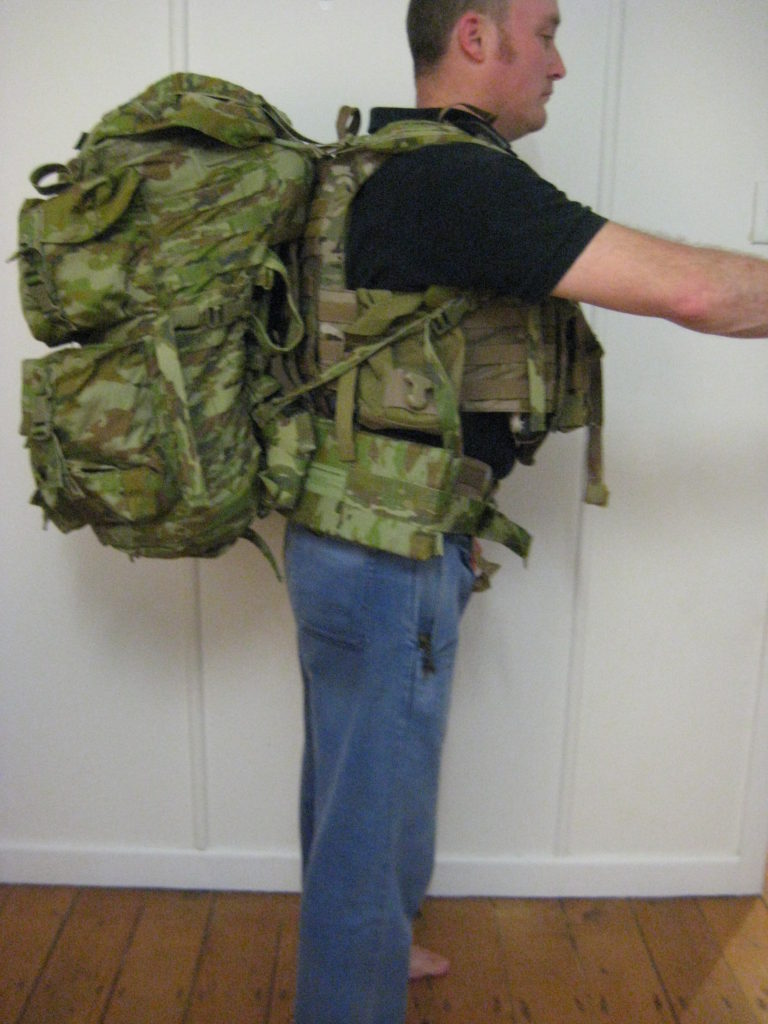
.
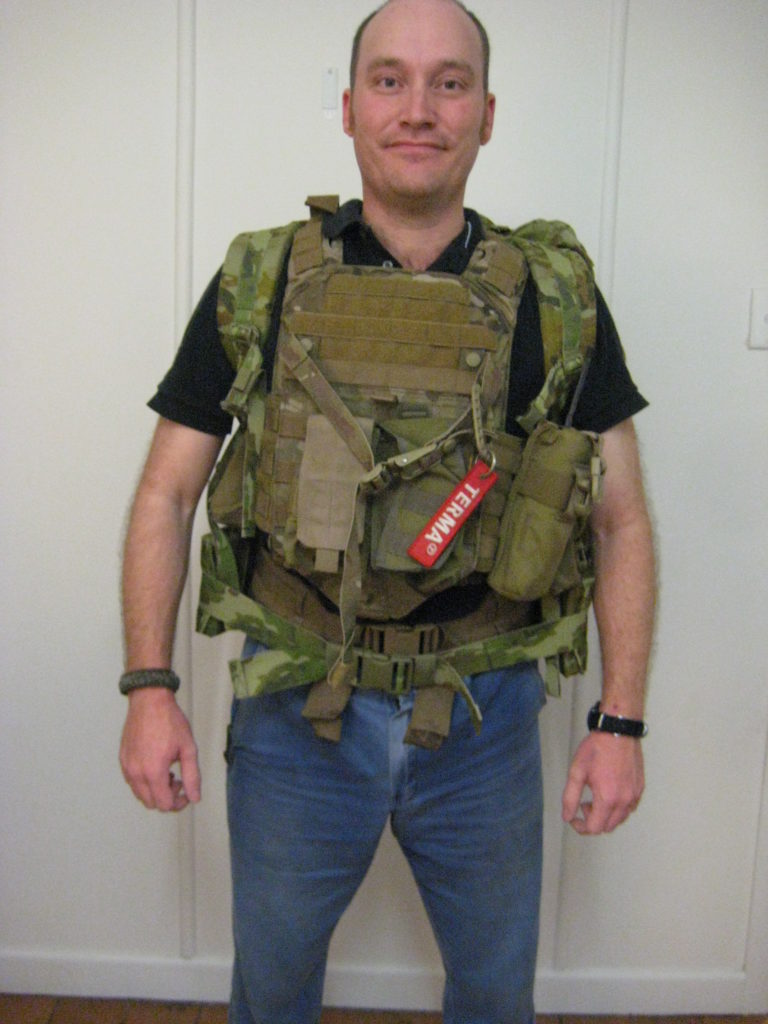
.
It should be noted, that this pack is Version 4 of the SCE tender design. The initial version I originally saw in the 2011/2013 time period at Land Warfare Conference had significant flaws. This was proven by a Battalion of the RAR (Royal Australian Regiment) suffering a large number of spinal injuries from their first major usage of it.
Initial issue of this pack has been ongoing since early this year (2016).
.
PROS –
There are some good things about this design.
Perhaps the most promising is that it is ALICE compatible. By this, the rucksack can be adapted to many other frames available currently in the market, whether that be old ALICE frames, the DEI plastic 1606 variants or the Mystery Ranch NICE frame. Most Army units I’m aware of specify that only issued load bearing equipment is to be used, however there is often some leeway with regards to frames. This will be a major benefit to whoever has to use this equipment.
The rucksack has some features integrated into it that end-users have been requesting for many years. Many of these features are now industry standard in commercial designs.
So at least the sack itself is usable in its standard format.
.
Dimensions of the rucksack when worn are somewhat favourable. It carries a useful load, that isn’t too large, generally below the level of the head – allowing unimpeded movement of the head during patrolling. Because of the rucksack’s square shape, I do however, consider it a bit too wide for close country.
The dorsal pouches on the corners make the pack wider, thus exacerbating the issue.
.
CONS –
This pack is essentially yet another warmed-over and modernised ALICE pack. Whilst the ALICE design is a tried and true design – time, knowledge and design expertise has moved on from the 1960’s when the design was first fielded.
There are several things that strike me as glaring design issues and, dare I suggest, serious flaws.
The fact that the pack examined for this review was up to Version 4 for a completely new design is troubling. I’m sure that spin doctors for the ADF and ADA will harp on that this is the benefit of adaptive design. But to my mind, after some years in product development roles and tender applications in industry, this speaks volumes of design immaturity and other technical and procedural issues.
Why is a brand-new item of equipment already up to the fourth version when it should have been acceptable when the design was adopted by the ADF?
.
I’ll outline my concerns in the same order that I have described this pack in.
.
Frame –
The One299 frame seems brittle compared to any other plastic frame on the market I’ve examined. I have my doubts about its long term longevity, or even suitability in a service environment.
In fact, I was recently sent a picture of a frame failure from a soldier who had it snap on the first day of use: putting his sleeping bag away during morning routine.
There are other anecdotal stories floating around of frames failing from the simple military experience of being dropped from the back of a truck.
Other anecdotes suggest 17 frame failures out of a platoon. This does not bode well for this item.
The locking lugs are a major concern. They seem weak, and unable to soak up serious use and abuse.
Anecdotal evidence reveals that out of a platoon sized organisation (30-40 personnel) being issued this pack, at least 7-10 frames were damaged during transit and unable to be issued. I find this very concerning.
I would consider this brittle frame at significant risk of failure, and therefore causing a spinal injury during use.
The design of the frame itself does not lend itself to being stable whilst being worn. This imposes a significant risk of spinal injury to the wearer as the load will attempt to spin away from the centre of gravity.
.
Harness –
The lack of load lifter straps on the shoulder straps are a concern.
Load lifting straps on shoulder harness straps are essential for adjusting the way the carried load interacts with the body on true cross country travel. On level ground and heading downhill, the load lifters should be taut, to keep the load as close to the shoulders as possible. When ascending slopes, the load lifters are loosened off to allow how the centre of gravity of the load interacts with the back, which allows more comfort and less fatigue to be suffered.
That this essential feature was not integrated into this pack harness, unlike any other commercial design currently available in the market, suggests a lack of design knowledge from ADA.
I consider this a fault in the design. Good field equipment should be aiding the wearer in harsh and hostile environments by reducing fatigue – not adding to fatigue levels inflicted upon an already tired and occupied end-user. Even the less-than-suitable previous generation issue pack that this item is supposed to replace had this feature (albeit poorly executed).
.
The quick release buckles are another problem area. They are not rated for anywhere near the normal load carried by units in the ADF on normal operations.
In addition, since the quick release buckles are only anchored at the top, under load they will move free of the padding, digging into the wearer’s ribcage.

.
The hip belt is a major head scratcher. As mentioned, there is absolutely no contouring of this for the human frame. It will not interact well with the human body whilst worn, nor with belt webbing or body armour.
Wearing the hip-belt done up actually has the foam belt digging into my ribs in any position other than standing upright.
That was quite an experience, to have the quick release buckles digging into my ribs a few inches higher than the large plank of foam digging in below them.
.
Much fanfare was made by ADA a few years ago about some revolutionary work conducted with the Ergonomics Department at a southern university. The harness I was able to examine then at the Land Warfare Conference in 2012 and 2014 wasn’t too bad. I am left wondering then, what happened to all the government money that was spent in that project, since it is obvious that none of that knowledge or expertise has carried over to this design?
.
Joining the rucksack to the frame was problematic. For what I assume to be a purpose designed rucksack and frame combination, it doesn’t seem to mate well together. What appears to be loops to secure the rucksack to the frame do not actually match up in any fashion.
I first set up the frame at the “Large” size. There seemed to be a lack of correct lashing points to the frame.
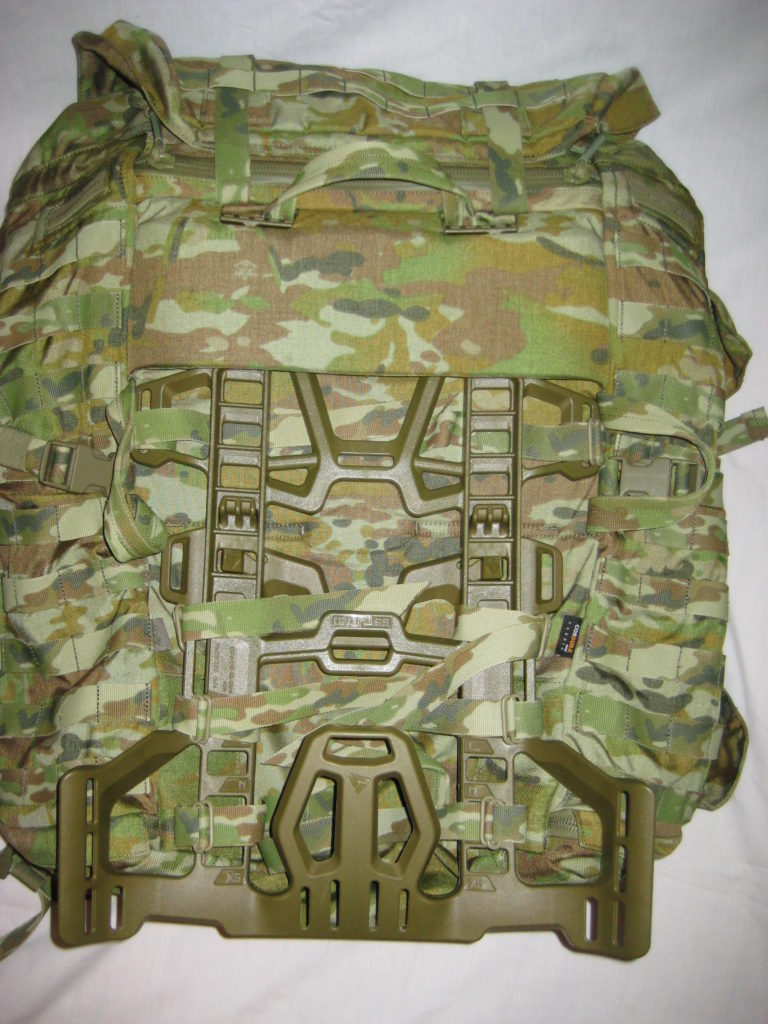
.
Then I set up the frame for the “Small” size. This also seemed to display a lack of correct lashing points to the frame. Because of the shorter frame length, the bottom of the rucksack hung below the frame. This has serious implications for smaller soldiers wearing this pack: a short back-length has serious lack of space from the overhanging rucksack that will interfere with belt mounted webbing (fighting order) or the movement of the wearer’s legs. Shorter end-users such as women now entering the Combat Arms are given short shrift yet again.
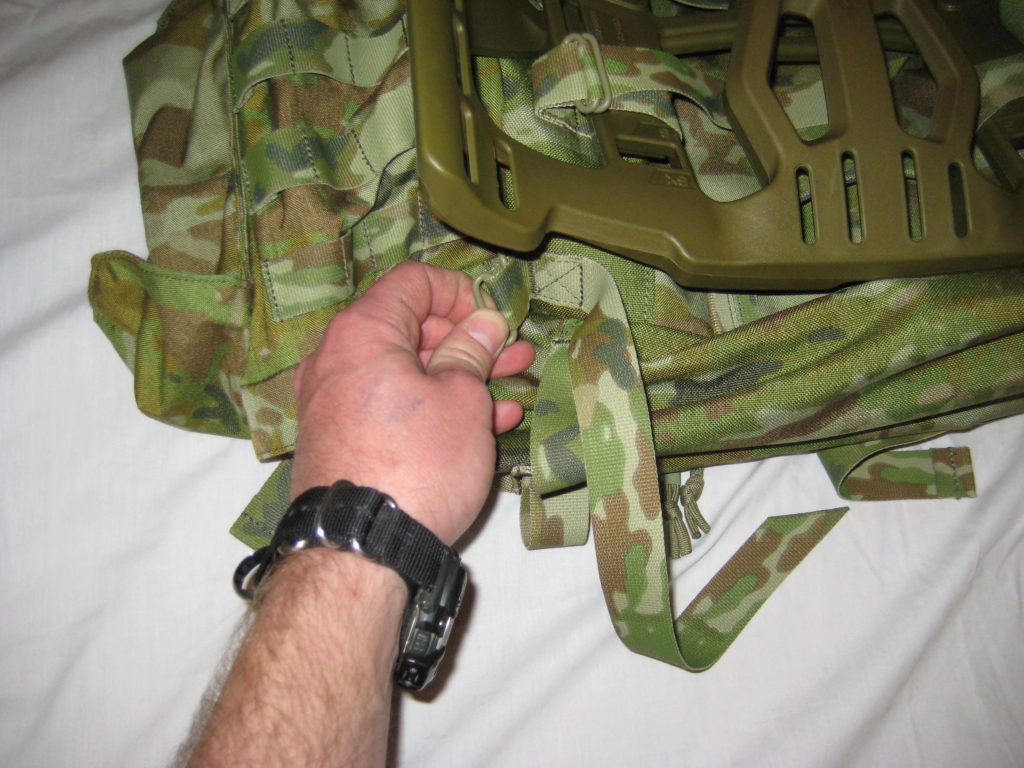
.

.
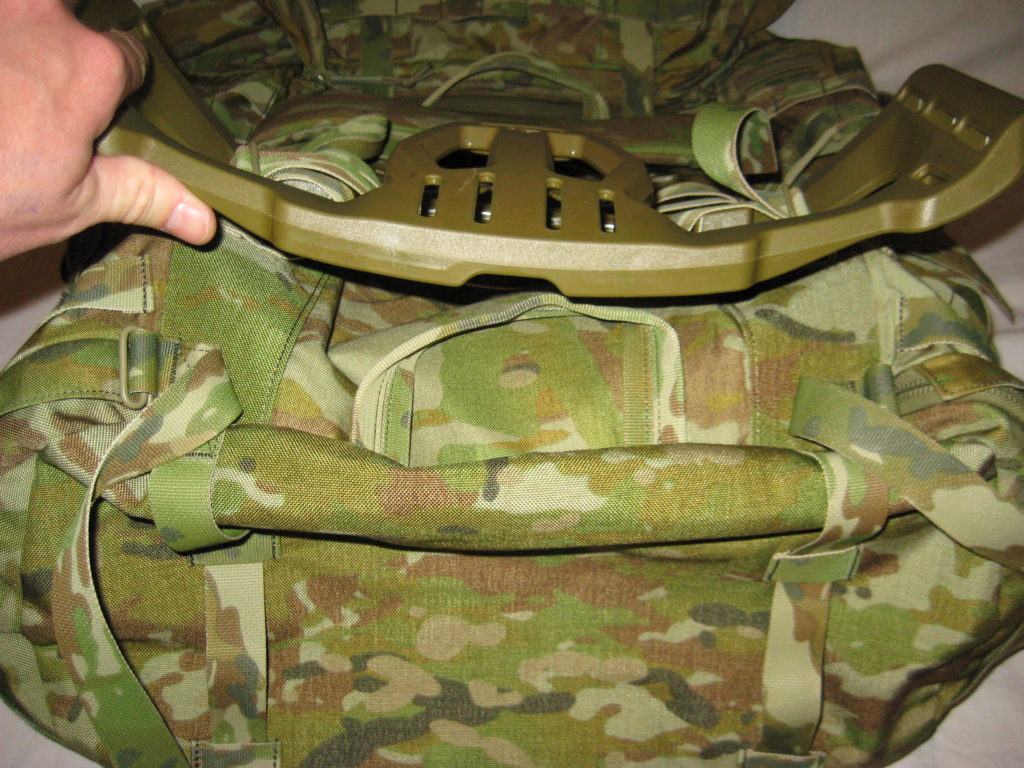
.
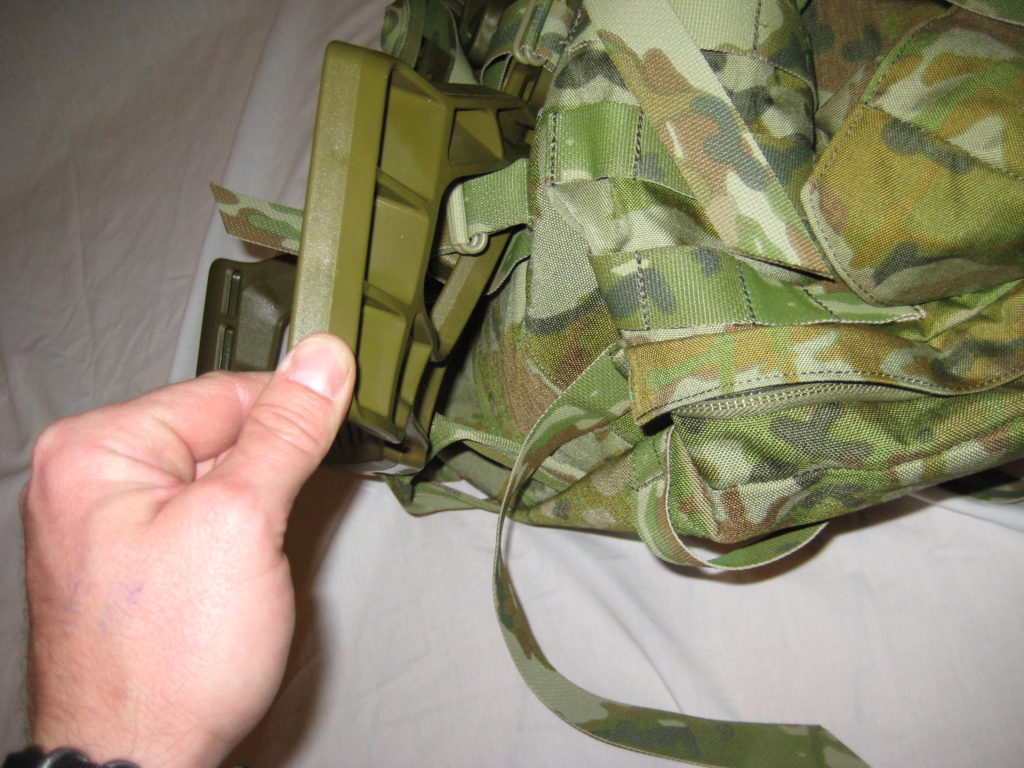
.
The final back-length tried was my normal “Medium”. Even then, there seems to be a lack of correct mounting points for the rucksack to the frame.
In addition, is the friction loops used in conjunction with AMCP printed webbing tape. This webbing tape appears to be polypropylene, which is not known for it’s abrasion resistance. Add the camouflage pattern printed onto the surface, and under high abrasion forces as seen on attachment points for the rucksack to the frame will see this webbing tape become frictionless and unable to be properly secured.
.
Rucksack –
Initial impressions of the rucksack are… rough… for want of a better term.
Stitching is of inconsistent count. With materials such as these, strength of stitched joins coms from an accurate consistent stitch count delivered by good quality sewing machines that are well maintained.
Speaking of strength, there appears to be absolutely no bar-tacking used in the construction of this rucksack. How this can even be considered as suitable or fit for purpose in this day and age is beyond me.
.
Sticking with construction, the rucksack appears to be made of at least four bolts of cloth. All have different appearances and sheens. This makes me wonder about the NIR (Near Infra-Red) spectral camouflage compliance of the material. This is an essential requirement on the modern battlefield, since even low-tech enemies have access to high-end commercial night-vision equipment.
This NIR compliance extends to the fastex buckles used on this pack. I strongly believe the buckles used for this design are not NIR compliant. I lack the equipment to test this, but a visual comparison to known NIR compliant plastic hardware and a further comparison to known non-compliant civilian hardware shows the buckles on this pack is more comparable to the non-NIR compliant civilian market buckles.
.
Whilst the rucksack has many features that are considered industry standard now, end-users have been requesting these for over twenty years. The rucksack designer seems to demonstrate a complete lack of understanding of how to fully integrate the design elements together into a coherent device that aids the wearer and how they interact with their equipment during use.
Other commercial designs I’ve examined in the past have some very subtle methods to allow a more optimal transfer of the weight from the rucksack through the frame onto the wearer, in order to maximise comfort safety levels. This is lacking in this design.
A great example is the antennae ports on the lid: whilst a great design point, they are covered by the straps used to secure the lid, thereby adding an opportunity for somewhat delicate equipment to be sheared off by sharp edges on webbing tape.

.
Similar issues apply to the radio access zip at the top of the rucksack. It is covered by the straps to secure the pack, thereby rendering its usefulness less than optimal.
There is also a distinct lack of side access zip for the different models of manpack radio currently in service in the ADF. It is noted that many Reserve units are issued the RT500 radio set, which has the control panel located on the side of the pack. Many Regular units are issued the Harris set, which has the control panel located at the top. I am reliably informed that this side radio access zip was documented to have been a part of the tender requirements. How this design was accepted for the tender lacking this feature when competing tender entries had this side access zip raises some serious questions in my mind.
When fully loaded, the lid is not long enough to cover the throat, nor is it able to be adjusted to do so. This has serious implications when trying to prevent the ingress of foreign matter into the pack and for full utilisation of the PALS field on the lid for attachment of pouches. If the lid isn’t long enough when fully loaded, then any pouches (such as for carrying M18A1 Claymores) will end up smacking the wearer in the head. This is obviously not a desired outcome. This makes the PALS rows essentially unusable.
The straps used to secure the top flap and bottom sleeping bag compartment are free floating, and are secured via a couple of webbing loops. Since these straps are free floating, there is a high chance of them being abraded and failing. Due to their location, there is a chance that the pouches in this area will be made unserviceable as well.
.
The zip for the sleeping bag access is not shielded from dirt and dust being jammed into it from normal usage. This will wear out the zip and cause failures.
The external pouches seem ill thought-out, and not conducive to correct balancing of the load to prevent injury to the wearer. In addition, the inverted pouches are likely to lose equipment stored in them due to a simple well-known scientific principle known as gravity.
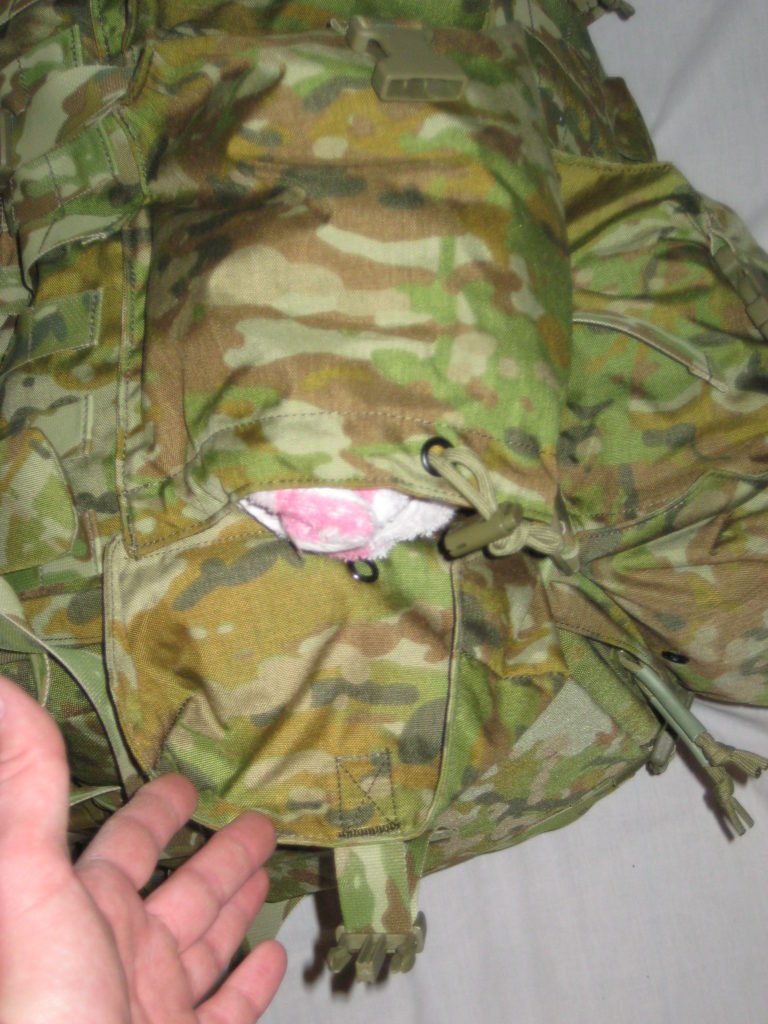
.
Perhaps the biggest issue I have with this pack, beside the shoddy design is one of the major reasons this pack was supposed to have been awarded the SCE tender was to have capability for local content and manufacture. This was one of the reasons that other tender entries were rejected was lack of local manufacturing capability.
I found manufacturers tags that announced that this product was made in Vietnam.

.
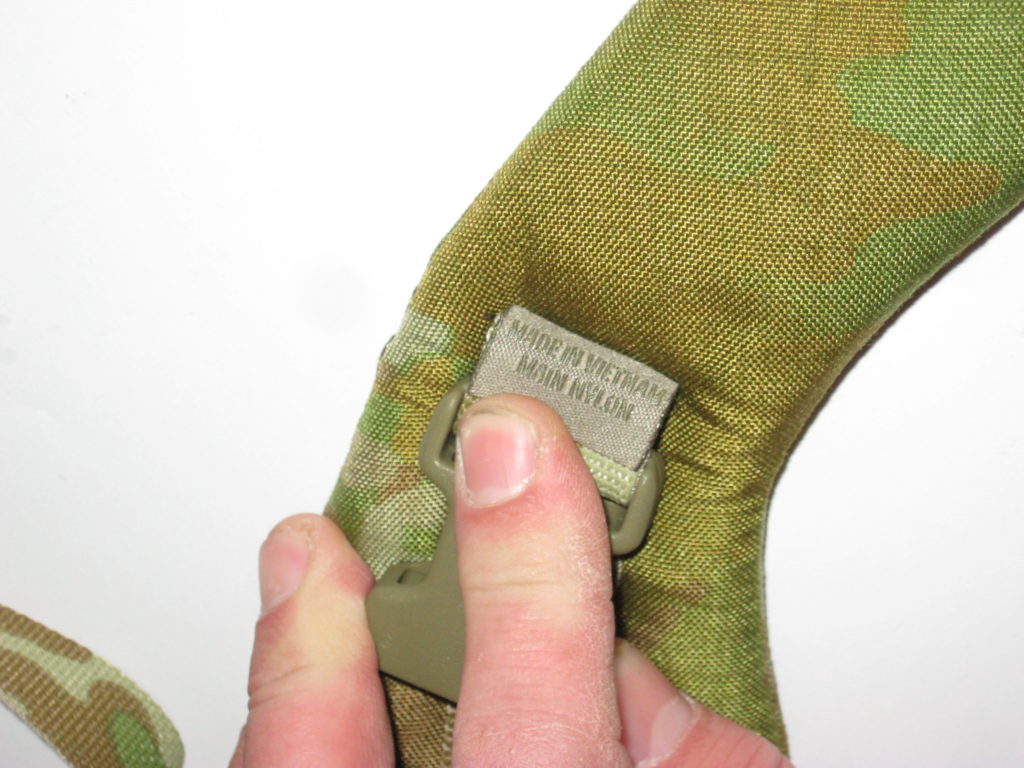
.
Perhaps another indicator of the Quality Control and Quality Assurance behind this pack, was the discovery of a manufacturing tool left behind inside the main compartment of the pack by factory staff. Whilst such things can happen to anyone, it would seem to be part a recurring trend seen with this pack for sloppiness. In the last 25 years plus I’ve been using receiving and buying packs, I’ve never yet found tools like this left behind.

.
In use –
Since this is simply a warmed-over ALICE pack, assembling the pack was no real problem – it was a reflection of my misspent youth to go back to such an archaic system.
Actual use and assessment of this pack has been limited to two training walks totalling ten (10) kilometres distance (approximately 6.21 miles) with a load of approximately twenty kilograms (approximately 45 pounds). The reason for the limited assessment was quite simple: comfort of a light load such as this was less than stellar. Nowadays, with my injury management practices and current employment of walking long distances every day carrying equipment in a service role, I am loathe to do anything that prevents me from working or exacerbating old injuries.
The harness was quite loose in the top end, with the load wanting to spin away from me.
The hip belt’s lack of ergonomics really became obvious as soon as anything other than standing upright and stationary was attempted. During movement, such as walking or bending in any way, it would dig into my ribs.
It should be noted that the hip belt was very difficult to get any amount of decent tension when attached to the frame. It actually started slipping off the frame during use for me.
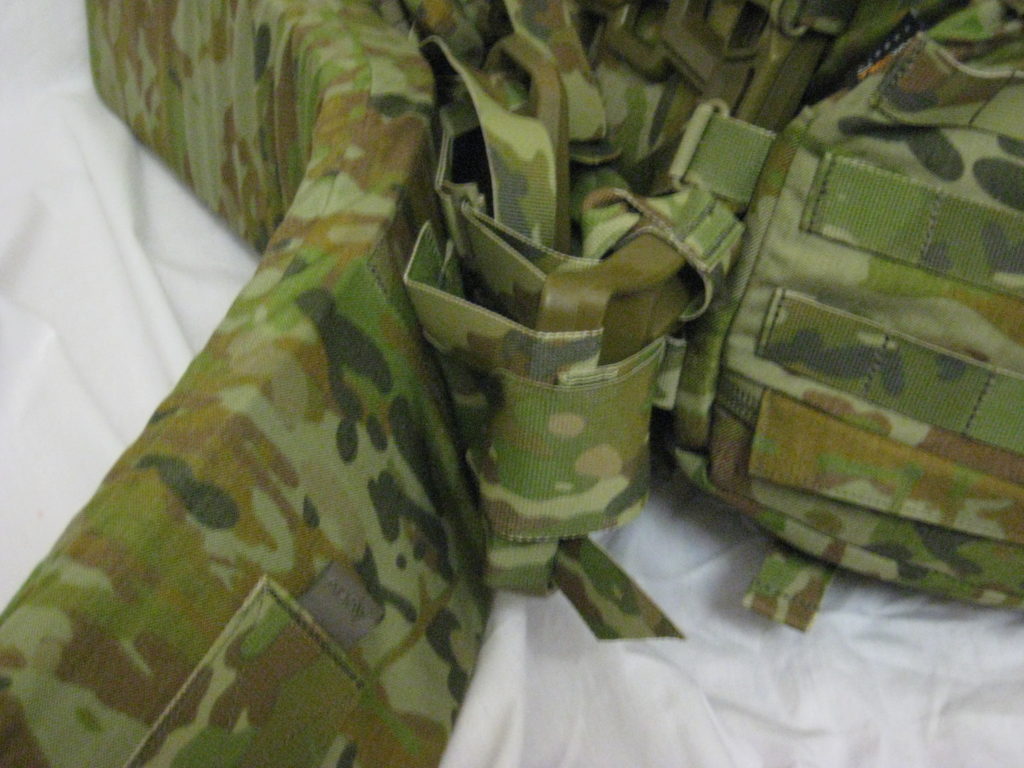
.
During the short distance travelled, the projection on the frame that poked into the small of the back was quite noticeable and quite annoying, despite the large plank of foam to pad it.
This projection though, is necessary to prevent the frame snapping if too much load is applied with the rucksack/harness combination is over-torqued during attachment or use.
As the pictures above demonstrate, a test fit with belt webbing was conducted. As expected, the hip belt of the pack was in conflict with the pouches of the fighting load.
A test fit with a plate carrier and Mystery Ranch BASE (review seen HERE) demonstrated a complete lack of compatibility. It can even be seen in the pictures the odd angle imparted on my body by the pack interfacing with the plate carrier. Just the test fit was enough to convince me that further distance work would not be conducted.
.
.
SUMMARY:
In summary, I find it quite puzzling and troubling how this pack was selected over the commercial offerings that were offered for the SCE tender.
The pack has a laundry list of appropriate features and design points, but lacks full integration of these features into the design to present a coherent, functional item.
What was supposed to be essential tender requirements that led to other tendered packs being eliminated from the tender process seems to have been ignored or disregarded.
The fact that this pack is Version 4 of a newly issued item, speaks volumes to me about the maturity of design before being submitted to tender. In the commercial world, an immature, unfinished design simply wouldn’t be received well, by tender assessors or end-users.
The sack portion is at least somewhat functional, but I foresee large after-market sales of frames necessary to make a silk purse out of a sow’s ear.
Posted in Long Range, Military, Packs & Webbing by 22F with 11 comments.
Leave a Reply